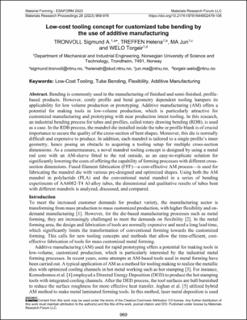| dc.contributor.author | Tronvoll, Sigmund Arntsønn | |
| dc.contributor.author | Treffen, Helena | |
| dc.contributor.author | Ma, Jun | |
| dc.contributor.author | Welo, Torgeir | |
| dc.date.accessioned | 2023-04-27T11:44:27Z | |
| dc.date.available | 2023-04-27T11:44:27Z | |
| dc.date.created | 2023-04-26T16:44:42Z | |
| dc.date.issued | 2023 | |
| dc.identifier.citation | Materials Research Proceedings (MRP). 2023, 28 969-976. | en_US |
| dc.identifier.issn | 2474-3941 | |
| dc.identifier.uri | https://hdl.handle.net/11250/3065315 | |
| dc.description.abstract | Bending is commonly used in the manufacturing of finished and semi-finished, profilebased products. However, costly profile and bend geometry dependent tooling hampers its applicability for low volume production or prototyping. Additive manufacturing (AM) offers a potential for making tools in low-volume production, which is particularly attractive for customized manufacturing and prototyping with near production intent tooling. In this research, an industrial bending process for tubes and profiles, called rotary drawing bending (RDB), is used as a case. In the RDB process, the mandrel die installed inside the tube or profile blank is of crucial importance to secure the quality of the cross-section of bent shapes. Moreover, this die is normally difficult and expensive to produce. In addition, each mandrel is tailored to a single profile’s inner geometry, hence posing an obstacle to acquiring a tooling setup for multiple cross-section dimensions. As a countermeasure, a novel mandrel tooling concept is designed by using a metal rod core with an AM-sleeve fitted to the rod outside, as an easy-to-replicate solution for significantly lowering the costs of offering the capability of forming processes with different crosssection dimensions. Fused filament fabrication (FFF)—a cost-effective AM process—is used for fabricating the mandrel die with various pre-designed and optimized shapes. Using both the AM mandrel in polylactide (PLA) and the conventional metal mandrel in a series of bending experiments of AA6082-T4 Al-alloy tubes, the dimensional and qualitative results of tubes bent with different mandrels is analyzed, discussed, and compared. | en_US |
| dc.language.iso | eng | en_US |
| dc.publisher | © Materials Research Forum | en_US |
| dc.rights | Navngivelse 4.0 Internasjonal | * |
| dc.rights.uri | http://creativecommons.org/licenses/by/4.0/deed.no | * |
| dc.title | Low-cost tooling concept for customized tube bending by the use of additive manufacturing | en_US |
| dc.title.alternative | Low-cost tooling concept for customized tube bending by the use of additive manufacturing | en_US |
| dc.type | Peer reviewed | en_US |
| dc.type | Journal article | en_US |
| dc.description.version | publishedVersion | en_US |
| dc.source.pagenumber | 969-976 | en_US |
| dc.source.volume | 28 | en_US |
| dc.source.journal | Materials Research Proceedings (MRP) | en_US |
| dc.identifier.doi | https://doi.org/10.21741/9781644902479-106 | |
| dc.identifier.cristin | 2143610 | |
| dc.relation.project | Norges forskningsråd: 317777 | en_US |
| cristin.ispublished | true | |
| cristin.fulltext | original | |
| cristin.qualitycode | 1 | |

